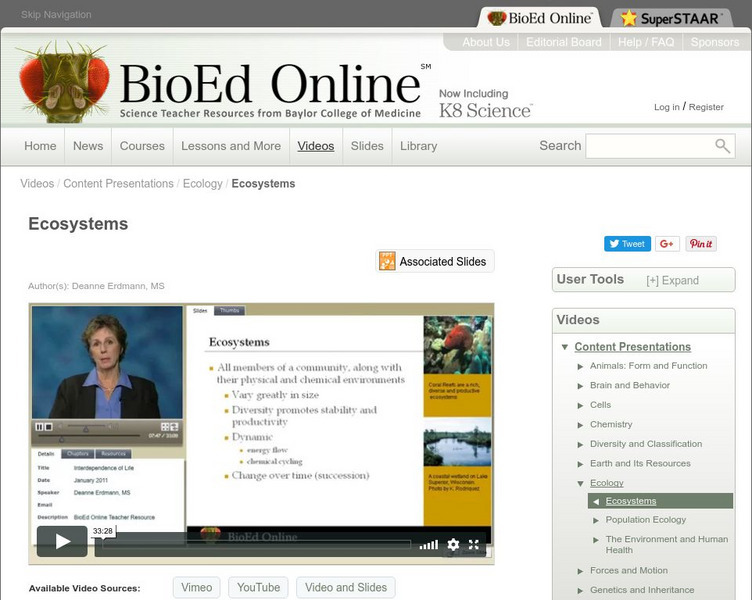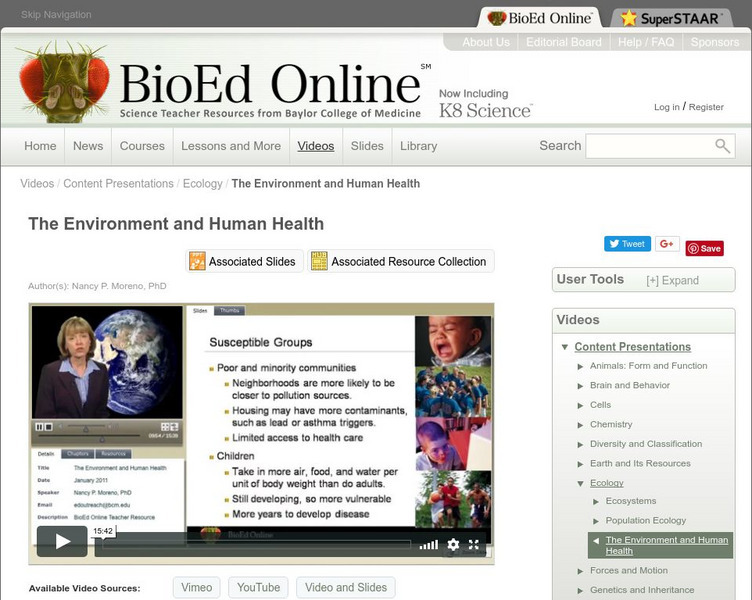Crash Course Kids
Fabulous Food Chains
What is a food chain? Energy flows between living things in a food chain. This is the focus of a video that explains how food chains work.
Crash Course Kids
Feed Me: Classifying Organisms
How do different types of living things get the energy they need? This is the focus of a video that describes how carnivores, herbivores, and omnivores get the energy they need to live.
Crash Course Kids
Gotta Eat!
Why do we eat? We eat because we need energy, and humans need energy to grow. This is the focus of a video that explains why organisms need food to live.
Crash Course Kids
Climate Change
What affects might an ecosystem undergo if the climate changes? This is the focus of a video that describes how a tiny change in an ecosystem can "throw everything off."
TED-Ed
Why Is Biodiversity So Important?
There are millions of plant and animal species on the planet, but why do we need so many? Follow along with this short video as it explains how biodiversity helps strengthen ecosystems, allowing them to adapt to change so that life...
TED-Ed
I'm Batman
When you think about bats, what comes to mind? Vampires? Rabies? After watching this short video you'll have a whole new appreciation for these terribly misunderstood mammals.
TED-Ed
Feedback Loops: How Nature Gets Its Rhythms
Explore the role of feedback loops in maintaining nature's delicate balance with this short science video. Introducing the concepts of positive and negative feedback, multiple examples are presented that explore the intricate web of...
TED-Ed
What's Hidden Among the Tallest Trees on Earth?
Hidden hundreds of feet above the ground in the redwoods of Northern California is a whole world that was just waiting to be discovered. This video tells the story of Stephen Sillett who, inspired by his grandmother, set out to...
TED-Ed
From the Top of the Food Chain Down: Rewilding Our World
A eloquent narrative and unique animation expound on the megafauna and megaflora that once dominated the planet and helped keep ecosystems in balance. Is there anything that can be done to undo the damage we've done? The speaker proposes...
Scholastic
Study Jams! Changes in Ecosystems
Our scholarly friends head to the lake to go fishing and are unpleasantly surprised by the algae filling the water. They talk about primary and secondary succession as different ways that ecosystems are changed. Show the short video,...
NeoK12 Education
Pond Ecology
Do you have a pond in your backyard? While typically used for recreational or aesthetic purposes, ponds actually provide a habitat for several species. Identify some of the benefits aquatic plants have on pond ecosystems, and learn small...
Curated OER
Tell Me Why - Environment and Ecosystems
All of the species in our world are part of what is called a trophic level. Basically, it determines an organism's position in the food chain. Introduce your learners to the basic levels and have them identify more organisms that could...
Curated OER
Life in the Polar Regions
Take a look at the coldest, windiest, and driest place on earth: the arctic! Very few species exist here, and those that do have undergone several adaptations to ensure their survival. Learn about some of these unique animals and their...
Curated OER
The Salt Desert Shrub Ecosystem
Take a peek at one of the harshest ecosystems in the world. Can you guess where it is? It's actually in Wyoming at the base of the Bighorn Mountains! Adapting to this harsh environment has been difficult, and only a few species are able...
TED-Ed
A Plant's-Eye View
Why is it important to look at the world from other species' points of view? Author Michael Pollan claims it is a way to reanimate the earth, realize Darwinian insights, and to take the food we need from the earth while healing it in the...
Teacher's Pet
Succession
Causes of ecological succession include lava flows, receding glaciers, forest fires, and farming. The video explains both primary and secondary succession. It also describes the steps followed during a typical succession.
Curated OER
Wetlands - Pond Study
Observe a pond's tiniest life forms. Zoom in on Daphnia, also called water fleas, a type of crustacean that often dwells on the pond floor.
PBS
Pbs Learning Media: On the Yukon River
In this video segment adapted from the Yukon River Panel, visit fishing communities along the Yukon River and see how Alaska Native peoples exercise stewardship of salmon to ensure that it remains a central food source and cultural...
PBS
Pbs Learning Media: Studying the Antarctic Sea Floor
Studying life on the seafloor beneath Antarctica's thick ice is a major challenge for ecologists. Learn about a new device that can reach those icy depths in this video segment adapted from WomenInAntarctica.com. [4:39]
BioEd Online
Bio Ed Online: Ecosystems
Ecosystems are composed of all interacting organisms (biota) along with their physical and chemical environments. Physical aspects of an ecosystem, called abiotic components, include variables related to temperature, sunlight, soil, and...
BioEd Online
Bio Ed Online:the Environment and Human Health
In the following video students will learn how the environment impacts human health and the ecosystems around us, on both a small/local and large/global scale. [15:42]
PBS
Pbs Learning Media: Melting Permafrost
In this video adapted from the International Institute for Sustainable Development, see melting permafrost and hear Alaska Native peoples and Western scientists discuss its impact on Inuit culture and resources.
PBS
Pbs Learning Media: The Spirit of Subsistence Living
In this video adapted from the University of Alaska, Anchorage, Alaska Native people of Chevak teach visitors about the beauty of Cup'ik culture and the spirit of the earth, sea, and animals.
PBS
Pbs Learning Media: Oil Contaminants Hidden From View
This video adapted from KTOO explores why the beaches of Latouche Island and Knight Island, Alaska, contain remnants of an oil spill and discusses its resulting impact on the Alutiiq community of Chenega Bay.3m 37s



















